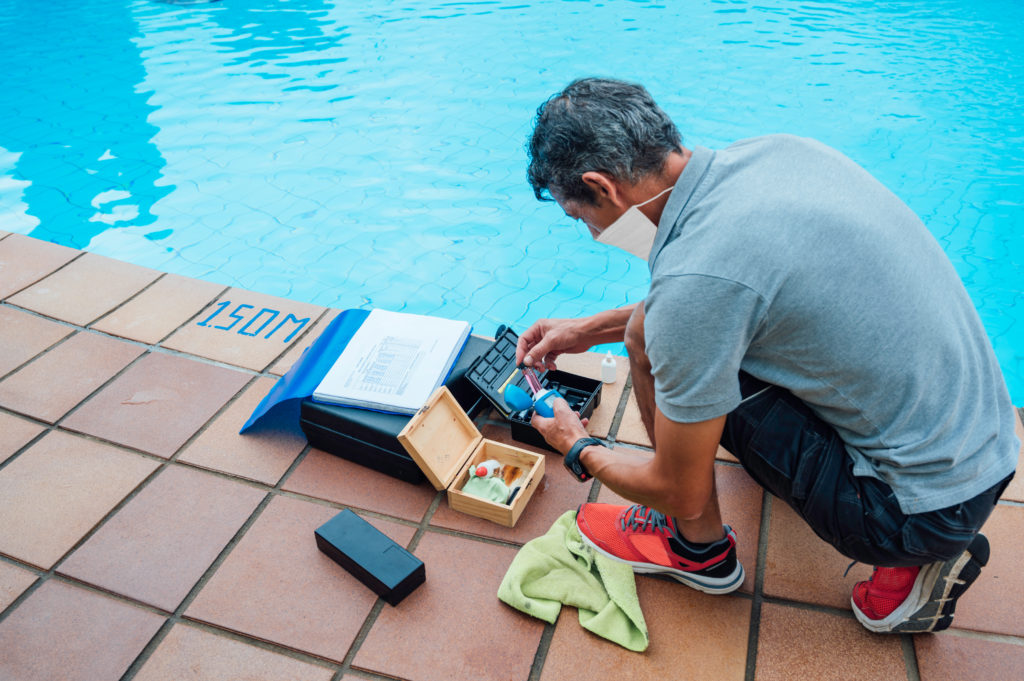The importance of pool maintenance cannot be overstated. It impacts swimmer safety and your reputation. Unfortunately, however, pool maintenance costs can take up a significant portion of your annual budget. This article presents industry best practices for swimming pool maintenance, along with affordable, easy-to-apply strategies to help you keep your pool clean and functioning efficiently.
Three C’s of Accurate Pool Maintenance
The basics of how to keep a pool clean are circulation, cleaning, and chemistry. With a strong foundation in these three key areas, you’ll have much less work to do.
Circulation
Proper pool circulation is critical to keeping your swimmers safe and healthy. Lack of adequate circulation results in algae infestation, debris pile-up, cloudy water, and other issues that make the job of keeping your pool clean much harder.
- Keep your filtration system running 24/7. Keep the system running at least 8 hours a day if you can’t manage an around-the-clock schedule. The warmer the temperature, the more you need to run your filtration system, so keep this in mind and aim for the maximum if possible.
- Keep the filter clean. This probably seems obvious, but it’s easily overlooked. When your filter gauge is around 10 psi above the normal reading, it’s time to backwash the filter.
- Clean the skimmer basket. The skimmer basket is a critical element in your effort to keep your pool clean. If the basket is clogged, the filtration system will have to work much harder, ultimately breaking down the system. So clean the skimmer at least twice a week.
- Pay attention to the direction of your pool jets. It’s best to point them downward and away from your skimmer. The downward direction will ensure proper circulation at the bottom of your pool.
Cleaning
Next up in the three C’s is how to clean a pool. Your cleaning tools depend on your pool type, size, location, and budget. At a minimum, you’ll need a pool brush, net, and vacuum. You can purchase a mechanical pool cleaner or robot if your budget allows it.
- At least once a week, vacuum the pool.
- You should also brush and skim the surface for debris every day.
- Taking the time to clean your pool will lengthen the life of your filtration systems and keep your swimmers happy.
Chemistry
Ensuring the correct chemical balance in your swimming pool is a crucial element in swimming pool maintenance. If you neglect this step, you’ll be dealing with bacteria and other microbes, as well as a build-up of algae. You’ll also find yourself dealing with expensive pool repairs and maintenance costs. What do you need to check?
- pH
- Calcium hardness
- Sanitizer
- Metals

How often should you check your chemical balance?
Weekly or more often if you’ve hosted swim events or if it’s your busy season. Also, if you’re creating an above-ground pool maintenance calendar, you’ll want to schedule your chemical balance checkup more frequently.
What is the proper swimming pool chemical balance?
- Chlorine levels in the pool should be between 1 and 3 ppm at all times.
- The pH level should be between 7.2 and 7.8.
- The acceptable range for calcium hardness should be 200-400 ppm and Cyanuric Acid at 30-50 ppm.
- Proper alkalinity helps you maintain a good pH balance. It’s best to remain at an alkalinity of 80-120 ppm.
- Metals can discolor your swimming pool water and degrade the surface. The most common metals are manganese, copper, and iron. Use a scale and stain remover to keep the pool clean.
How do you check the chemical balance?
You have two main options: test strips or a liquid test kit.
Shocking The Pool
What is pool shocking?
This may sound like a severe undertaking, but actually, pool shocking is merely the process of adding chlorine or non-chlorine chemicals to the water in your swimming pool to:
- kill algae, bacteria, and other harmful pathogens
- quickly raise your chlorine level, and
- break apart chloramines (combined chlorine)
Why is it necessary?
Debris and environmental waste naturally build up on the surface and pool floor. So shocking the pool is a crucial part of your pool maintenance schedule to keep the water clean and clear.
How do I shock the pool?
- Choose a time when the pool is closed.
- Grab your shock chemical package and read the instructions to find the amount of shock you’ll need to mix.
- In most cases, you’ll add water to the shock mix. Some mixes, such as lithium hypochlorite, can be poured directly into your swimming pool. You can also use liquid pool shock.
- Make sure your pool pump is running.
- Pour the pool shock mixture into the water, following along the pool’s edges or near the jets depending on the pool shock mixture you use.
- Wait and keep the pool pump running for a minimum of six hours. Additionally, run your pool filter for at least 24 hours to eliminate any algae or germs.
- Test the water to ascertain the chlorine levels. You want the free chlorine levels to drop to 1 to 3 ppm.
- Be sure to wear safety glasses and gloves when shocking the pool.
Tips To Keep The Pool Clean in The Long-Term
- Create a cleaning schedule.
- Routinely test the water chemistry.
- Monitor chlorine levels.
- Clean the pool filters regularly.
- Skim the water and vacuum for dirt and debris at least weekly (or daily if you have a lot of swimmers).
- Maintain the water levels.
- Properly winterize the pool.
Conclusion
If you create a cleaning schedule and stick to it, you’ll find that taking care of a pool is easy and affordable. You’ll also save money on pool repairs and maintenance. The most important things are:
- Water circulation
- Cleaning
- Keeping the pool free of bacteria and other microbes by maintaining the correct chemical balance at all times.
